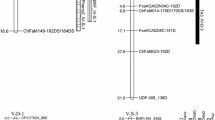Abstract
Thirty bi-parental progenies were generated using 45 genotypes from the University of California (UC) strawberry breeding population as parents. Both parent genotypes and their offspring were classified for photoperiod insensitivity, or day-neutrality, for flowering using a late-season flowering score and the number of inflorescences per plant recorded during late summer. Complex Segregation Analysis of these traits indicated that their distributions were best explained by a genetic model that postulates a single major locus with partial dominance for day-neutrality in combination with a background of polygenic and environmental variation. The frequency of the allele conferring day-neutrality was estimated as p = 0.59–0.62 in this experimental population. Genotypic values for the inferred major locus were estimated as a = 1.12 and d = −0.81 for the flowering score, and a = 4.93 and d = 2.41 for inflorescence number. Further resolution of inheritance patterns were obtained by comparing the phenotypic variance for each trait with estimates obtained by insertion of these genotypic class values and allele frequencies into standard quantitative genetic models, and by the comparing variance components estimated using a mixed model analysis with and without inferred genotypic classes as a fixed effect. These comparisons suggest that the major gene determines 80.5% and 73.9% of the additive genetic variance for flowering score and inflorescence number respectively. One complicating feature of the results obtained here is that a non-Mendelian model of segregation fit statistically better than a fixed Mendelian model. The genetic parameters estimated using this non-Mendelian model were essentially identical to those obtained with fixed segregation; hybrid and octoploid ancestry, selection affecting flowering response, and limited number of generations in the analysis are discussed as possible explanations of this result.
Similar content being viewed by others
References
Ahmadi, H., R.S. Bringhurst & V. Voth, 1990. Modes of inheritance of photoperiodism in Fragaria. J Am Soc Hort Sci 115: 146–152.
Arulsekar, S., R.S. Bringhurst & V. Voth, 1981. Inheritance of PGI and LAP isozymes in octoploid cultivated strawberries. J Am Soc Hort Sci 106: 679–683.
Boldman, K.G., A. Kriese, L.D. Van Vleck, C.P. Van Tassell & S.D. Kachman, 1995. A Manual for use of MTDFREML. A set of programs to obtain estimates of variances and covariances. U.S.D.A., Agricultural Research Service.
Bringhurst, R.S., 1990. Cytogenetics and evolution in American Fragaria. HortScience 25: 879–881.
Bringhurst, R.S. & V. Voth, 1984. Breeding octoploid strawberries. Iowa State J Res 58: 371–381.
Cargill, E.J., T. Famula, G.M. Strain & K.E. Murphy, 2004. Heritability and segregation analysis in US Dalmatians. Genetics 166: 1385–1393.
Clark, J.H., 1938. Inheritance of the so called everbearing tendency in strawberry. Proc Am Soc Hort Sci 35: 67–70.
Comstock, R.E. & H.F. Robinson, 1948. The components of genetic variation in populations of bi-parental progenies and their use in estimating the average degree of dominance. Biometrics 4: 254–266.
Corva, P.M. & J.F. Medrano, 2001. Quantitative Trait Loci (QTLs) mapping for growth traits in the mouse: A review. Genetique, Selection, Evolution 33: 105–132.
Edwards, A.W.F., 1978. Likelihood. An Account of the Statistical Concept of Likelihood and its Application to Scientific Inference, 2nd edition Cambridge University Press, London.
Elston, R.C., K.K. Nasmboodrii & C.J. Glueck, 1975. Studies of the genetic transmission of hypercholesterolemia and hypertriglyceridemia in a 195 member kindred. Ann Hum Genet 39: 67–87.
Falconer, D.S. & T. Mackay, 1996. Introduction to Quantitative Genetics. Longman Press, New York.
Hancock, J.F., J.J. Luby, A. Dale, P.W. Callow, S. Serce & A. El-Sheik, 2002. Utilizing Fragaria virginiana in strawberry cultivar development: Inheritance of photoperiod sensitivity, fruit size, gender, female fertility, and disease resistance. Euphytica 126: 177–184.
Hancock, J.F. & S. Serce, 2005. Inheritance of day-neutrality in octoploid species of Fragaria L. J Am Soc Hort Sci (in press).
Lynch, M. & B. Walsh, 1998. Genetics and analysis of quantitative traits. Sinauer, Sunderland, Mass.
Nicolle, M. & G.J. Galletta, 1987. Variation in growth and flowering habit of Junebearing and everbearing strawberries. J Am Soc Hort Sci 112: 872–880.
Ourecky, D.K. & G.L. Slate, 1967. Behavior of the everbearing characteristics in strawberry. Proc Am Soc Hort Sci 91: 236–241.
Powers, L., 1954. Inheritance of period of blooming in progenies of strawberries. Proc Am Soc Hort Sci 64: 293–298.
S.A.G.E. Statistical Analysis for Genetic Epidemiology, Release 5.0, 2004. Computer program package available from Statistical Solutions Ltd, Cork, Ireland.
Sakin, M., J.F. Hancock & J.J. Luby, 1997. Identifying new sources of genes that determine cyclic flowering in Rocky Mountain populations of Fragaria virginiana ssp glauca Staudt. J Am Soc Hort Sci 122: 205–210.
Scott, D.H., 1936. Size, firmness, and time of ripening of fruit of seedlings of Fragaria virginiana Duch. crossed with cultivated strawberry varieties. Proc Am Soc Hort Sci 74: 388–393.
Searle, S.R., G. Casella & C.E. McCulloch, 1992. Variance Components. J Wiley and Sons, Inc, New York.
Shaw, D.V., 1995. Comparison of ancestral and current-generation inbreeding in an experimental strawberry breeding population. Theor Appl Genet 90: 237–241.
Shaw, D.V. 2003. Heterogeneity of segregation ratios from selfed progenies demonstrate polygenic inheritance for day neutrality in strawberry (Fragaria ×ananassa Duch.)
Smith, S.P. & H.U. Graser, 1986. Estimating variance components in a class of mixed models by restricted maximum likelihood. J Dairy Sci 69: 1156–1165.
Tourjee, K.R., J. Harding & T.G. Byrne, 1995. Complex segregation analysis of Gerbera flower color. Heredity 74: 303–309.
Wright, S., 1922. Coefficients of inbreeding and relationship. Am Nat 56: 330–338.
Author information
Authors and Affiliations
Corresponding author
Rights and permissions
About this article
Cite this article
Shaw, D.V., Famula, T.R. Complex segregation analysis of day-neutrality in domestic strawberry (Fragaria ×ananassa Duch.). Euphytica 145, 331–338 (2005). https://doi.org/10.1007/s10681-005-1945-0
Received:
Accepted:
Issue Date:
DOI: https://doi.org/10.1007/s10681-005-1945-0




